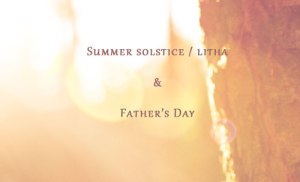Litha is also known as the Summer Solstice, Midsummer, Midsummer Night, Midsummer Night’s Eve, Gathering Day, Sun Blessing, Gathering Day, Feill-Sheathain, St. John’s Day. In England, The Day of Cerridwen and Her Cauldron, in Ireland, dedicated to the faery goddess Aine of Knockaine; Day of the Green Man in Northern Europe.
Usually celebrated around June 21, the Summer Solstice marks the time when the sun is at the highest point before beginning its slide into darkness.
In the Southern Hemisphere today is Yule, the Winter Solstice.
The word Litha has some interesting etymology behind it: “Litha is a modern name for this holiday, possibly based on a Saxon word; Aerra Litha being Saxon for “before Litha”, or June and Aeftera Litha being Saxon for “after Litha”, Litha being the month of July. Its modern use was started by Wiccans but has been adopted by some other Pagan groups as well.” (1)
For me I find it is a bittersweet sabbat, since it marks a ‘going away’ of the light. On the other hand, this is considered by many to be the start of summer and some of the best weather of the year can be expected now – English weather peculiarities aside though we’re currently having a heatwave where we had flash flooding last year.
Like Yule and the equinoxes, Litha is considered a ‘lesser’ sabbat, being primarily of astronomical significance.
In Wiccan and some other neo-pagan traditions the solstices are seen as the Holly and Oak king battling for supremacy (2), with the Holly King being victorious at the summer solstice and the Oak king winning at Yule.
Traditionally, Mother Goddesses, the pregnant Goddess – symbol of the forthcoming harvests – and goddesses of love and beauty are honoured. Sun gods and sun goddesses are celebrated at this time, as well as Father Gods.
This is a time of great power, prime for fertility rites, inspiration and other growth rituals, as well as healing and purification, divination and re-dedicating yourself to your chosen path. It is a good time for handfastings and weddings or for clearing away burdens and establishing a stable base.
Litha celebrations might involve Morris dancing, singing, storytelling, pageantry and feasting, and a bonfire which could provide luck to those brave enough to jump over the flames. Other rituals/celebratory activities include visiting a holy well, burning a cleansing bonfire, recharging your magical tools, leaving out milk/honey for the Fair Folk, and going early berry picking.
Correspondences
Foods and drinks especially suitable for celebrations include lemons, oranges, peppers, strawberries, summer squashes, tomatoes, corn, honey, honey cakes, melted cheese dishes, fresh vegetables, summer fruits, summer squash, pumpernickel bread, ale, mead, fruit juice, carrot juice, red wine, lemon tea.
Trees, Flowers and Herbs: birch, white lilies, roses, St John’s Wort and mugwort, mistletoe, apple, cedar, elder, fir, hawthorn, holly, ivy, lemon, oak, pine, peach, rowan, daisy, iris, honeysuckle, lavender, marigolds, saffron, sunflowers.
Gather vervain and basil to to be used during the winter months.
Traditional colours of Litha: gold, yellow, red, blue, green, orange, white, tan.
Other correspondences: The sun; sun wheel, sun dials, seashells; blades; daisy chains; stone circles, feathers, fire, candles, wands, yellow and green gemstones, especially emerald and jade amber, tiger’s eye, frankincense, myrrh, sandalwood, chamomile, bee, butterfly, caterpillars, sea creatures, wren, robin, horses and cattle, faeries, dragons, blades, percussion instruments.
Sources and further reading:
1 Litha Information Sheet (http://walkingthehedge.net/hedge/litha-info-sheet/)
2 The Legend of the Holly King and the Oak King (http://paganwiccan.about.com/od/yulethelongestnight/p/Holly_KIng_Yule.htm)




